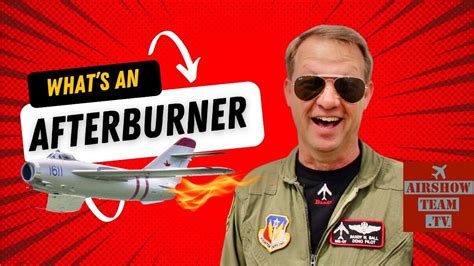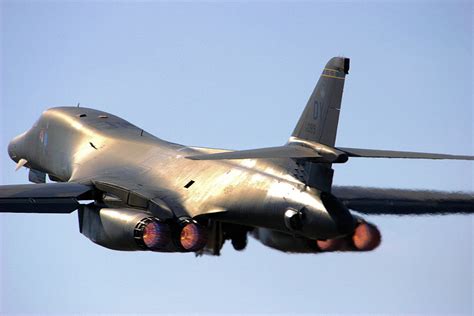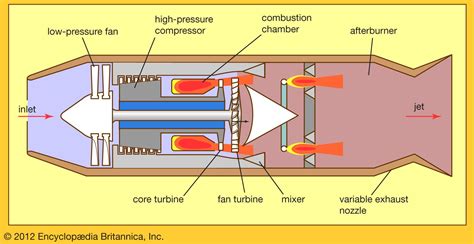The concept of afterburners, also known as reheat, has been a crucial component in the development of high-performance jet engines, particularly in military aviation. Afterburners are essentially secondary combustion systems that inject fuel into the hot exhaust gases of a jet engine, reigniting them to produce a significant increase in thrust. This technology has been pivotal in enhancing the speed and maneuverability of aircraft, especially during critical phases of flight such as takeoff, combat, and intercept missions. Understanding how afterburners work requires a delve into the principles of jet propulsion and the specific mechanisms that allow for this additional thrust generation.
Key Points
- Afterburners increase thrust by injecting fuel into the hot exhaust gases of a jet engine.
- The process involves the use of a secondary combustion system that reignites the exhaust gases.
- Afterburners are typically used in high-performance military aircraft to enhance speed and maneuverability.
- The technology requires sophisticated control systems to manage fuel injection and prevent engine damage.
- Afterburner operation is associated with increased fuel consumption and reduced engine lifespan.
Principle of Operation

The basic principle behind the operation of an afterburner involves the injection of fuel into the exhaust nozzle of a jet engine. Normally, the exhaust gases from a jet engine are hot but still contain a significant amount of oxygen, which can support further combustion. By injecting fuel into these gases, they can be reignited, producing a substantial increase in temperature and, consequently, a significant rise in the velocity of the exhaust gases. This increase in exhaust velocity directly translates to an increase in thrust, according to Newton’s third law of motion. The process is highly efficient in terms of thrust augmentation but comes at the cost of increased fuel consumption and reduced engine lifespan due to the higher thermal stresses involved.
Components and Mechanism
The afterburner section of a jet engine is located after the turbine, in the exhaust nozzle. It consists of a fuel injection system, an ignition system, and a flame stabilizer. The fuel injection system sprays fuel into the exhaust gases, the ignition system provides the spark needed to initiate combustion, and the flame stabilizer ensures that the flame is maintained within the afterburner section, preventing it from blowing out or flashing back into the engine. The entire process is controlled by sophisticated engine management systems that carefully regulate the amount of fuel injected and the timing of ignition to optimize performance while preventing overheating or other forms of engine damage.
| Component | Description |
|---|---|
| Fuel Injection System | Sprays fuel into the exhaust gases for reignition. |
| Ignition System | Provides the spark for initiating combustion in the afterburner. |
| Flame Stabilizer | Maintains the flame within the afterburner section for stable combustion. |

Applications and Limitations

Afterburners are primarily used in military aircraft where the need for high speed and rapid acceleration is paramount. Fighters, interceptors, and certain types of attack aircraft are common users of afterburner technology. However, the use of afterburners is not without its limitations. The significant increase in fuel consumption during afterburner operation limits the duration for which an aircraft can use this mode, typically reserving it for critical phases of flight. Additionally, the thermal stresses imposed on the engine during afterburner operation reduce the lifespan of the engine, necessitating more frequent maintenance and overhaul. Despite these limitations, the tactical advantages offered by afterburners make them an indispensable component of modern military aviation.
Future Developments
Research into more efficient and less fuel-intensive methods of thrust augmentation continues, with advancements in materials science and engine design promising potential improvements in afterburner technology. The development of more efficient combustion systems, advanced cooling techniques, and novel materials capable of withstanding the extreme temperatures generated during afterburner operation are areas of active research. Furthermore, the integration of afterburners with other advanced propulsion technologies, such as scramjets (supersonic combustion ramjets), is being explored for future high-speed aircraft applications.
What is the primary purpose of an afterburner in a jet engine?
+The primary purpose of an afterburner is to increase the thrust of a jet engine by injecting fuel into the hot exhaust gases and reigniting them.
Why are afterburners primarily used in military aircraft?
+Afterburners are primarily used in military aircraft because they provide a significant increase in speed and maneuverability, which are critical during combat and intercept missions.
What are the main limitations of using afterburners?
+The main limitations of using afterburners include increased fuel consumption and reduced engine lifespan due to the higher thermal stresses involved.



